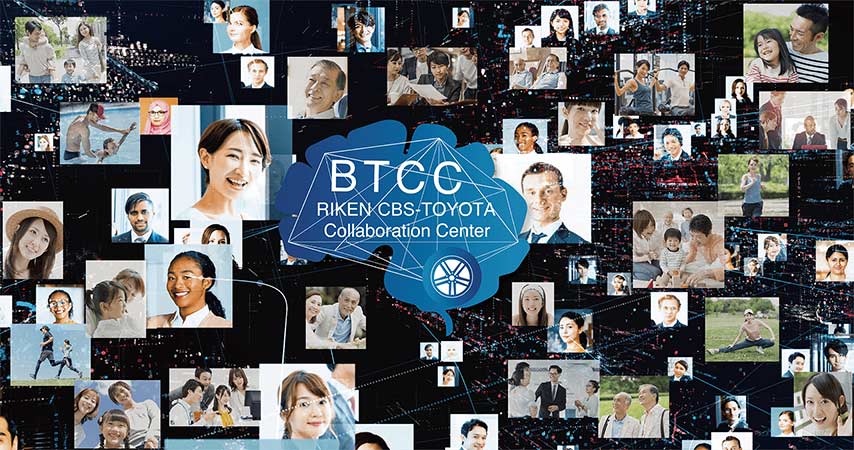

April 28, 2021
Why Is Toyota Conducting Brain Research:
Aiming for Well-Being and Respect for Individuality
The Frontier Research Center of Toyota Motor Corporation (Toyota) is venturing into the possibilities created by integrating brain science and engineering: the aim is to generate innovation for the future society. As a part of that process, in 2007, Toyota established an organization for comprehensive collaboration, the RIKEN CBS-TOYOTA Collaboration Center (BTCC), with the RIKEN Center for Brain Science (Wako, Saitama Prefecture [RIKEN CBS]). Since then, they have undertaken joint brain research.
At BTCC, we talked about the latest brain research with Dr. Keiichi Kitajo, who leads the Rhythm-based Brain Information Processing Unit, and Toyota members Hitoshi Yamada, Katsunori Koda, and Yuhei Yamaguchi in Dr. Kitajo’s laboratory. On entering the laboratory, the first noticeable items were ten metronomes side by side, their pendulums swinging back and forth. Visitors naturally wonder why they should be there.
Q. What’s the connection between the metronomes and brain research?
Dr. Kitajo:
These ten metronomes started swinging at different times. But as they swing from left to right on the same board, they gradually adopt the same timing: they get synchronized. The same thing actually happens in the brain. There’s a phenomenon whereby oscillating electric signals—like the metronome movements—are produced in individual brain cells. The timing of their respective oscillations becomes aligned before diverging again a short time later. Our research in this laboratory focuses on measuring brain waves and such synchronized patterns.
Q. Why are you examining the synchronized patterns of brain waves?
Dr. Kitajo:
We believe that through such synchronized patterns, it’s possible to visualize the individuality of information processing in the human brain. Brain wave synchronization is thought to play an important role in information processing and information exchange by mediating the communication between distinct areas in the brain. The latest research indicates that those synchronized patterns vary among human individuals.
Q. What kind of individuality have you been able to visualize?
Dr. Kitajo:
For example, it’s sometimes difficult for some people to switch their attention: the tendency is to focus too much on one thing. The following images display metastable states, which are synchronized patterns that are weakly attracting states. The figures show people with a strong tendency in that regard (top) and ones with a weak tendency (bottom). We know that people with a strong tendency have few metastable states. By measuring brain waves, it will be possible to predict people’s characteristics that previously could be assessed only through behavior and psychological surveys.1
Q. Why is Toyota promoting visualization of individuality as a BTCC initiative?
Yamaguchi:
As a mobility company that provides a diverse range of mobility services, Toyota regards its mission to be to “mass produce happiness”. BTCC initiatives promote research from the three approaches of mind, body, and society toward increasing human well-being. We believe these BTCC initiatives will provide the basic research necessary to achieve Toyota’s mission. Whether a particular state constitutes well-being differs from person to person. We believe that understanding human individuality and the technology for visualizing it are necessary for bringing about that well-being.
Yamada:
By means of brain data, Dr. Kitajo is conducting research related to visualizing psychological well-being and taking individuality into account. He has produced academically valuable results about the visualization of individuality.2
Dr. Kitajo:
BTCC initiatives began in 2007 and are currently operating for the fourth term (2019 to 2021). Through this continuing collaboration, RIKEN researchers and Toyota members are able to understand one another’s thinking and to have in-depth discussions about matters ranging from research policies to details of research content. And so, interesting research topics constantly emerge.
Q. How will psychological well-being research be developed in the future?
Koda:
To date, we’ve promoted research on extracting information about human individuality from brain data for visualization of psychological well-being. Dr. Kitajo is planning research to enhance the visualization of mental states by measuring the balance between substances in the brain that excite and those that suppress neurons in some areas.
Yamaguchi:
To achieve greater human well-being, we need research about encouraging such well-being as well as visualization. We also want to conduct research on such matters as the impact of exercise on the mind and the reciprocal changes produced in the other person’s mind through human relationships.
Q. We will look forward to that. Thank you for the very interesting discussion today. Where can people access information on the status of BTCC research?
Yamaguchi:
The latest information can be obtained from the BTCC website. Please take a look at it here.
Thank you very much.
References
- 1
- The metastable brain associated with autistic-like traits of typically developing individuals, PLOS Computational Biology 17(4): e1008929.https://journals.plos.org/ploscompbiol/article?id=10.1371/journal.pcbi.1008929 2021
- 2
- https://cbs.riken.jp/en/faculty/btcc/
Contact Information (about this article)
Frontier Research Center
- Email:
- xr-probot@mail.toyota.co.jp✉




